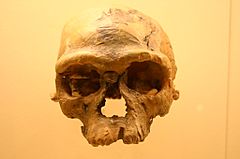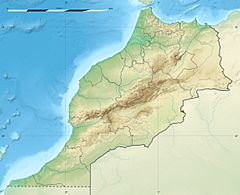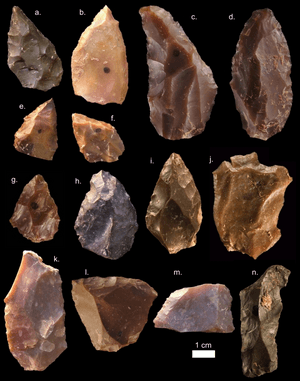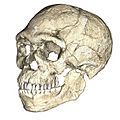Jebel Irhoud facts for kids
|
Adrar Ighud
|
|

Jebel Irhoud-1, dated 286±32 kya Smithsonian Natural History Museum
|
|
| Alternative name | جبل إيغود |
|---|---|
| Location | East of Safi. |
| Region | Morocco |
| Coordinates | 31°51′18″N 8°52′21″W / 31.85500°N 8.87250°W |
| Height | 592 m |
| History | |
| Periods | Lower Paleolithic |
| Associated with | Homo sapiens |
| Site notes | |
| Excavation dates | 1991 |
Jebel Irhoud (also called Adrar Ighud, in Berber: Adrar n Iɣud) is a very important archaeological site in Morocco. It is located near the town of Tlet Ighoud, about 50 kilometers (31 miles) southeast of Safi. This site is famous for the ancient human fossils found there. These discoveries have changed what we know about where and when modern humans first appeared.
Contents
Discovering Jebel Irhoud
The Jebel Irhoud site was first discovered in 1960. Miners found a skull in a cave while they were working. This led to many archaeologists coming to study the area. They found more human fossils and many stone tools. These tools and bones were buried deep in the ground.
The First Finds
When the first fossils were found, scientists thought they belonged to Neanderthals. Neanderthals were another type of ancient human. They lived in Europe and parts of Asia. For a long time, scientists believed that modern humans, called Homo sapiens, first appeared in East Africa.
A Big Surprise: Older Homo sapiens
Later, new studies and better dating methods changed everything. Scientists looked closely at the fossils from Jebel Irhoud again. They realized these bones were not from Neanderthals. Instead, they belonged to early Homo sapiens. This was a huge discovery!
The fossils were dated to be about 300,000 years old. This makes them the oldest known Homo sapiens fossils ever found. For example, a jawbone (called Irhoud 3) is about 286,000 to 32,000 years old. Other fossils and the stone tools found nearby are even older, around 315,000 to 34,000 years old.
Why Jebel Irhoud is Important
The discoveries at Jebel Irhoud are very important for understanding human history. Before this, most scientists thought Homo sapiens first appeared in East Africa. The Jebel Irhoud finds suggest that modern humans might have appeared across a wider area of Africa. This means our earliest ancestors could have lived in different parts of the continent.
Life of Early Humans
The stone tools found at Jebel Irhoud tell us about how these early humans lived. They used sharp flint tools for hunting and preparing food. These tools show that they were skilled hunters and gatherers. They lived in caves or rock shelters, using the natural protection from the weather and wild animals.
The fossils and tools help us imagine what life was like 300,000 years ago. It was a time when humans were just starting to develop many of the skills we have today. The Jebel Irhoud site gives us a rare peek into this very distant past. It helps us understand our own story as a species.
Images for kids
See also
 In Spanish: Djebel Irhoud para niños
In Spanish: Djebel Irhoud para niños





